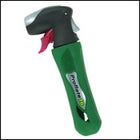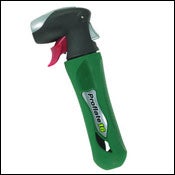CO2 inflators are great. Rather than laboriously hand-pumping a tire, you stick an inflator on the valve, squeeze a trigger, and before you can say, I once saw a guy on the Tonight Show blow up a hot water bottle with his mouth until it exploded,” you have a tire at 100 psi or better. So these days, most of my bikes have an Innovations Proflate 16 mini-pump ($25; performancebike.com), which takes a 16g non-threaded CO2 cartridge. Some people prefer an inflator that takes threaded cartridges, I think because the risk of a leak is perceived as lower. The Hurricane Quick Shot Pro ($25; performancebike.com) takes either threaded or unthreaded.
Innovations Proflate 16 mini-pump
 Innovations Proflate 16 mini-pump
Innovations Proflate 16 mini-pumpTheres not much risk of blowing out a tire; most cartridges fill only one tire, so you cant really over-inflate. Most, such as the Proflate and Quick Shot, also have a trigger that helps you control the flow so its not an all-or-nothing deal. The risk is that you might have a tube stuck under the tire rim, and the inflator is so fast that before you realize it the tube has pooched out and popped. So be sure you have the tube carefully installed.
The other risk is this: Youre on the road, and you have a flat. If you dont have a spare, then you need to inflate the bad tire to find the leak. And that may mean you waste a cartridge just finding the leak. And, if you have a really bad run of flats, you can easily run out of cartridges. So I tend to think CO2 fillers work best when youre in a group, and one of you has a pump. Use the inflators for quick repair of any flats, but the pump provides some backup in case you run out of cartridges after rolling over a handful of thumbtacks. For a pump, I still find the Zefal HPX-2 ($30; zefal.com), which has been around for forever, very hard to beat.
The 2008 Winter ���ϳԹ��� Buyers Guide is now online. From snow sports to trail-running to camping, get reviews of more than 300 new gear must-haves.


